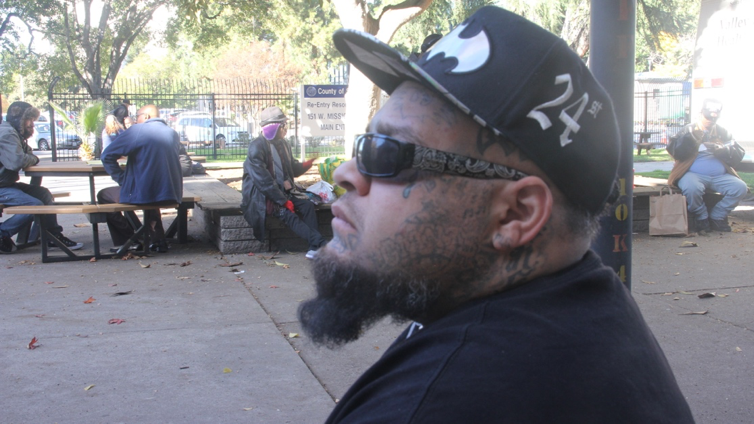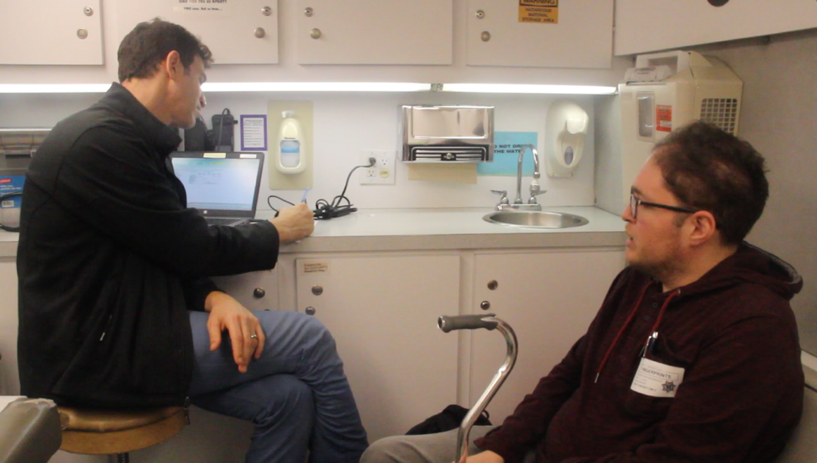
In the mobile medical clinic at Santa Clara County’s Reentry Resource Center, patients are seen on a first-come, first-served basis. About a dozen prospective patients sit quietly in the waiting area surrounding the adapted RV bus in downtown San Jose, while Dr. Ari Kriegsman, a primary care physician, evaluates a patient inside.
“I spent Saturday evening with my upper right chest, back, and arm entirely on fire,” says the patient, David Shivers, metaphorically. “It was a constant, throbbing, dull pain that I’ve never been through before. I don’t know what it was.”
Shivers was released from state prison in March of 2017. While incarcerated, he was diagnosed with a span of illnesses ranging from bipolar disorder to type 2 diabetes. His untreated diabetes also resulted in a chronic peripheral neuropathy—or nerve pain—that now radiates down his right arm. At 34-years-old, he uses a cane to walk.
“I am bipolar. I have anxiety, depression. I am diabetic. I have anemia.” added Shivers. “But the main thing I’m being treated for is chronic pain coming from several nervous system problems.”
Shivers relies on this clinic to help coordinate his complicated medical care. The clinic is part of a unique collaboration between Santa Clara County’s Valley Homeless Healthcare Program (VHHP) and Reentry Resource Center aimed at providing primary care, psychiatric care, and referral services to the homeless and formerly incarcerated in Santa Clara County.
In California, the need for clinics such as this one increased substantially following a 2011 U.S. Supreme Court ruling that mandated that California reduce its prison population due to overcrowding. The Court concluded in a 5-4 decision that overcrowding was the primary cause of inadequate medical and mental health care that constituted cruel and unusual punishment.
The California State Legislature responded to the 2011 Supreme Court ruling by passing Assembly Bill 109 (AB109), which shifted over 25,000 non-violent, non-sex offenders from state prisons to state parole or county supervision. In Santa Clara County—where the San-Jose based Reentry Resource Center is based—over 6,000 people have re-entered the community since 2011 under AB109.
In addition to AB109, California saw a further increase in the number of inmates being released from prison with the passing of Proposition 57 in 2016. The proposition gives non-violent offenders in the state’s criminal justice system the opportunity to earn early parole and/or time off their sentences for good behavior. By the end of 2017, over 2,000 inmates had been released statewide using Good Conduct Credits earned through Proposition 57.
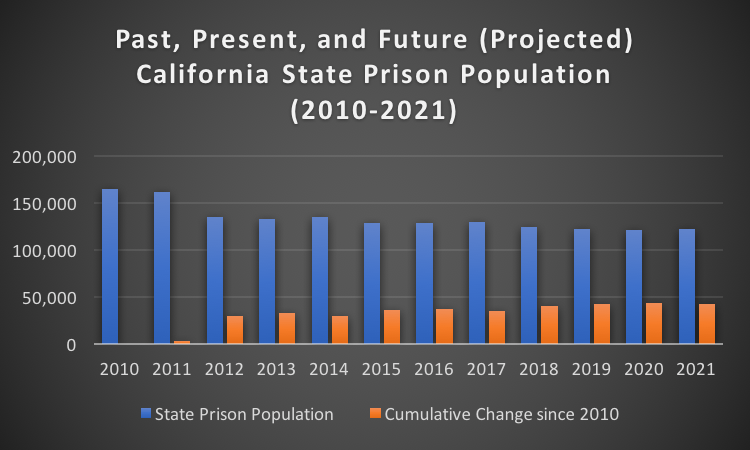
For those returning from jail or prison, the period immediately after release is an extremely vulnerable time. A seminal 2007 study published in the New England Journal of Medicine found that those released from state prison were 12.7 times more likely to die within the first two weeks of release compared to others of the same age, sex, and race. The most common cause of death was drug overdose, followed by cardiovascular disease, homicide, and suicide.
“When you hear that people are at an increased risk of dying the two weeks after they’re in prison, you’re like ‘this is a public health catastrophe!’” says Dr. Ari Kriegsman, medical director of Santa Clara County’s Reentry Resource Center.
“I think drug overdose is the first thing you have to think about,” he added. “We screen all of our patients for opioid use disorders.”
In response to the increased number of non-violent offenders returning from prison since 2011, a growing number of clinics targeting the formerly incarcerated have opened across the state to address the unique health challenges facing this population. Many have adopted a model first established by the San Francisco-based Transitions Clinic Network, which partners with twenty-one clinics across the country.
The model focuses on providing comprehensive primary care services for those with chronic illnesses and promotes partnership with other local organizations that address social determinants of health such as housing, food access, and income generation. Clinics also enroll eligible patients for free health insurance through programs such as Medi-Cal.
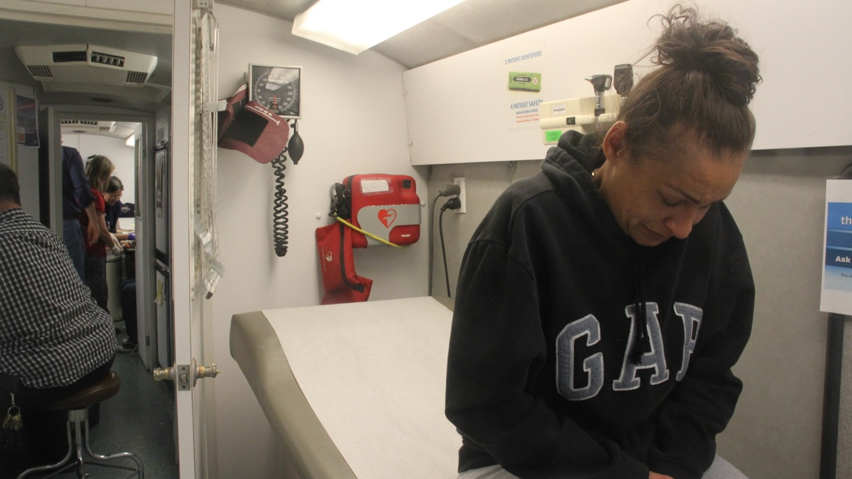
In California, the Santa Clara County Reentry Resource Center is one of seven clinics that have adopted the Transitions Clinic model. But the Santa Clara County clinic is unique in that it is completely funded with money given to the county through the Public Safety Realignment Act of 2011.
“A lot of the transitions clinics are doing amazing work, but they’re added onto existing clinics and might not have the financial resources that we have because we’re a county-funded program,” said Dr. Kriegsman.
In Santa Clara County and elsewhere, the model appears to be working. Before the Resource Center was established, approximately 30 percent of inmates released from the Santa Clara County Jail were connected to healthcare services upon release. Today, that number is closer to 70 percent.
“So what we did is we came up with criteria with the jail doctors [to identify] the sickest of the sick people,” said Kriegsman. “And all those people were scheduled one day per month in the custody clinic so the community health workers could go and meet them.”
Each clinic in the Transitions Clinic Network also employs at least one community health worker with a history of incarceration, who plays a critical role in the management and care of patients. At the Santa Clara County Reentry Resource Center, that role is filled by Tressa Hillman.
“Having been through this, I think the clients really connect with me,” said Hillman, who is one of two community health workers at the Reentry Resource Center. “I can tell them some of my experiences, and if the connection is there, they’re more willing to let you help them. I think that’s a big deal.”
Hillman was first incarcerated at the age of 18-years-old.
“I had a drug addiction that landed me in jail many, many times. And then later on in life I became homeless,” she said. “It was only for a short period but you have to really learn to get out of that cycle, and it’s a nasty cycle. So once I developed the skills to pull myself out, I wanted to share that with other people.”
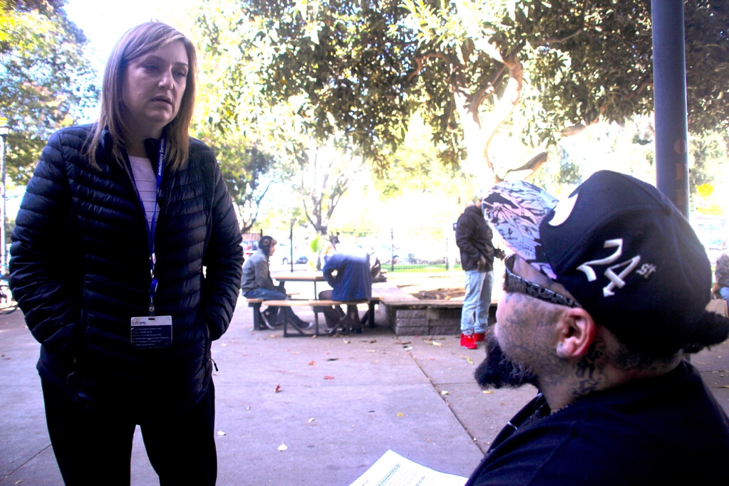
At the Reentry Resource Center, Hillman coordinates care for many of the most vulnerable patients, connecting them with resources for housing, food, and drug treatment programs. She will even occasionally go into the city’s homeless embankments to identify those who may benefit from the Center’s resources.
“I just know that when you’re desperate and you’re needing a change in life, there are places you can go to get resources and the Reentry [Center] is one of them. I just tell people that there are people out there who are looking to help you and who care,” she says.
Today, Hillman is counseling a client about potential housing options. The patient, Andre Jones, will be finishing three years on parole next month.
“I’ve never been this close,” Jones says.
“I’ve been real nervous. I did a lot of jail time, so I owe myself this. And if I could adapt to this, I could adapt to being out,” he added. “I just know, one day at a time—that’s what it takes.”
